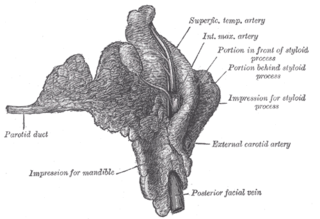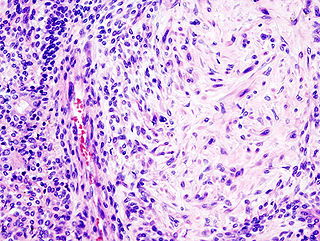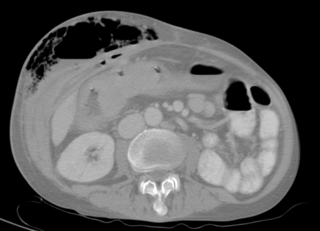
Exocrine glands are glands that produce and secrete substances onto an epithelial surface by way of a duct. Examples of exocrine glands include sweat, salivary, mammary, ceruminous, lacrimal, sebaceous, and mucous. Exocrine glands are one of two types of glands in the human body, the other being endocrine glands, which secrete their products directly into the bloodstream. The liver and pancreas are both exocrine and endocrine glands; they are exocrine glands because they secrete products—bile and pancreatic juice—into the gastrointestinal tract through a series of ducts, and endocrine because they secrete other substances directly into the bloodstream.
Saliva is an extracellular fluid produced and secreted by salivary glands in the mouth. In humans, saliva is 99.5% water plus electrolytes, mucus, white blood cells, epithelial cells, enzymes, antimicrobial agents such as secretory IgA, and lysozymes.

The salivary glands in mammals are exocrine glands that produce saliva through a system of ducts. Humans have three paired major salivary glands as well as hundreds of minor salivary glands. Salivary glands can be classified as serous, mucous or seromucous (mixed).

The paired submandibular glands are major salivary glands located beneath the floor of the mouth. They each weigh about 15 grams and contribute some 60–67% of unstimulated saliva secretion; on stimulation their contribution decreases in proportion as the parotid secretion rises to 50%.

The paired sublingual glands are major salivary glands in the mouth. They are the smallest, most diffuse, and the only unencapsulated major salivary glands. They provide only 3-5% of the total salivary volume. There are also two other types of salivary glands; they are submandibular and Parotid glands.

Parotitis is an inflammation of one or both parotid glands, the major salivary glands located on either side of the face, in humans. The parotid gland is the salivary gland most commonly affected by inflammation.

The parotid duct or Stensen duct is a duct and the route that saliva takes from the major salivary gland, the parotid gland into the mouth.

Pleomorphic adenoma is a common benign salivary gland neoplasm characterised by neoplastic proliferation of parenchymatous glandular cells along with myoepithelial components, having a malignant potentiality. It is the most common type of salivary gland tumor and the most common tumor of the parotid gland. It derives its name from the architectural Pleomorphism seen by light microscopy. It is also known as "Mixed tumor, salivary gland type", which refers to its dual origin from epithelial and myoepithelial elements as opposed to its pleomorphic appearance.

Oral mucocele is a clinical term for two related phenomena: mucus extravasation phenomenon and mucous retention cyst. Other names include mucous extravasation cyst, mucous cyst of the oral mucosa, and mucous retention and extravasation phenomena.

Sialadenitis (sialoadenitis) is inflammation of salivary glands, usually the major ones, the most common being the parotid gland, followed by submandibular and sublingual glands. It should not be confused with sialadenosis (sialosis) which is a non-inflammatory enlargement of the major salivary glands.

Sialolithiasis, is a condition where a calcified mass or sialolith forms within a salivary gland, usually in the duct of the submandibular gland. Less commonly the parotid gland or rarely the sublingual gland or a minor salivary gland may develop salivary stones.

In anatomy and physiology, a duct is a circumscribed channel leading from an exocrine gland or organ.

Salivary gland tumours or neoplasms are tumours that form in the tissues of salivary glands. The salivary glands are classified as major or minor. The major salivary glands consist of the parotid, submandibular, and sublingual glands. The minor salivary glands consist of 800-1000 small mucus-secreting glands located throughout the lining of the oral cavity.
Sialoendoscopy is a minimally invasive technique that allows for salivary gland surgery for the safe and effective treatment of obstructive salivary gland disorders and other conditions of the salivary glands. During sialoendoscopy a small endoscope is placed into the salivary glands through the salivary ducts that empty into the mouth. Sialoendoscopy is an efficient yet simple mode of treatment for major salivary gland obstructions, strictures and sialoliths. Depending on the obstruction, sialoendoscopy can be conducted under local anesthesia in an outpatient office or in the operating room under general anesthesia.

Salivary gland diseases (SGD) are multiple and varied in cause.
Ectopic salivary gland tissue which is located in sites other than the normal location is variously described as aberrant, accessory, ectopic, heterotopic or salivary gland choristoma.
Salivary duct stricture is narrowing of the duct of a major salivary gland.

Sclerosing polycystic adenosis is a rare salivary gland tumor first described in 1996 by Dr. Brion Smith. The major salivary glands, specifically the parotid gland and the submandibular gland, are affected most commonly. Patients usually come to clinical attention with a mass or swelling in their salivary glands in the 5th decade of life, with females affected much more commonly than males. Nearly all of the cases reported so far have a benign behavior, although there is a single case that has had an associated malignant transformation.


















